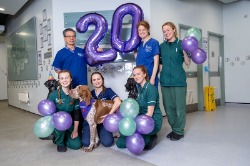The RVC Blood Donor Programme Reaches 20-Year Milestone
Clinical Connections – Spring 2024
Karen Humm, Associate Professor in Transfusion Medicine and Emergency and Critical Care, Charlotte Russo, Head Transfusion Medicine RVN, and Amanda Boag, Vice Principal (Clinical Services)
The RVC Blood Donor Programme is vital to the everyday functioning of the Queen Mother Hospital for Animals. The blood products it provides allow our specialist clinical teams to help hundreds of animals every year. The products are collected, prepared and delivered to patients via the Transfusion Medicine Service (TMS).
The TMS was established in 2004 by Amanda Boag (now Vice Principal for Clinical Services) and Gillian Gibson (now in private practice). At that time transfusion medicine was in its infancy in the UK and Europe. There were very few vets with expertise in this area and the highly trained role of a blood donor nurse had yet to be invented with passionate RVNs from a range of different backgrounds running blood donations when required.

Now in 2024, almost every service at RVC Small Animal Referrals uses donated blood products, with the most frequent users being the Soft Tissue Surgery Service, the Internal Medicine Service and the Critical Care Service. Some of our advanced treatments, such as cardiothoracic surgery and plasmapheresis, could not run without the support of the TMS.
Since 2004, our provision has built year on year to help more and more patients. In 2023 we performed 479 canine blood product transfusions, 163 feline transfusions and 69 xenotransfusions.
We can keep donated blood as whole blood but generally we split it into red blood cells, for anaemic patients, and plasma, which we use for dogs and cats with low levels of clotting factors. Plasma can also be useful in critically ill patients to support their circulatory system. In addition, our blood donor nurses also make special products to help patients with inherited diseases where they lack specific clotting factors, such as haemophilia.
We currently have 150 active canine donors and 62 felines. Our donors vary hugely – in blood type, breed and personality, but what all have in common is they are comfortable in the donor room and with us. Donations take about five minutes for both dogs and cats. The dogs love all the fuss they get and cats enjoy the snacks and strokes.
The focus of the RVC Blood Donor Programme is always to provide the best possible care to our amazing donors. We’ve worked hard over these past 20 years to understand how we can provide the best service to them and also how we can use the blood they provide in the most effective way.
Consequently, we conduct research into many aspects of the blood donation and blood transfusion process to understand how we can improve. We publish the results in journals so vets and vet nurses (and their blood donors and patients) around the world can benefit from our findings.
RVC blood donor studies and welfare
In 2017 we published the world’s first description of cats donating without sedation. This is now standard practice at the RVC and vets globally are recognising that cats don’t need a general anaesthetic or heavy sedation to give blood.
We’re always trying to ensure that we are performing blood donation to the highest possible standard. We’ve studied for signs of changes to the cardiovascular system in dogs after donating blood (and didn’t find any) and we’ve recently finished a study looking at whether the fluid therapy we give to cats after donation is necessary or whether they can go home shortly afterwards (as dogs do).
In 2020 a veterinary student conducted a study looking at why dogs and cats leave the Blood Donor Programme. She found that one in five of the cats that owners try to enrol as donors are not successful for either medical or temperament reasons underlining how special and valuable our feline donors are.
In 2020 and 2022 we published reports on the use of canine blood in anaemic cats (xenotransfusion). We found that dog blood can be an effective method of treating anaemic cats, but only in the short term, as the cats will break down the canine red blood cells quite quickly and you can’t give a second transfusion of canine blood.
We have performed high quality studies looking at whether removing white blood cells from blood transfusions is helpful and whether performing a crossmatch prior to transfusion in cats is worthwhile. We’ve helped really improve knowledge in these areas and the information we’ve learnt has allowed us to develop how we work.
